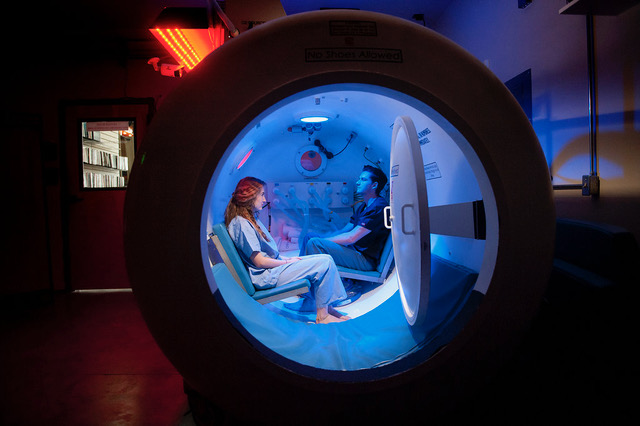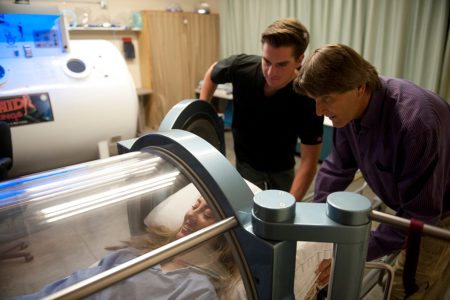“The body will heal when it is given the right environment,” said Phil Rainey, sitting in his newly relocated hyperbaric oxygen treatment (HBOT) clinic, Hyperbarics of Sun Valley. The space, located on River Street in Hailey, is modern and comfortable and contains two hyperbaric chambers. One, built for a single occupant, looks like a bed encased in a glass tube. The second, which can accommodate several people at once, appears more submarine-ish. It’s metal with round windows and has a large sticker proclaiming it “The Mermaid Lounge.”
Rainey, owner of Hyperbarics of Sun Valley, is a certified hyperbaric technologist and safety director. In 1985, he graduated from the U.S. Navy’s Second Dive School and became a deep-sea diver for the 294th Dive Detachment. Dr. Nancy Parry is the medical director for the clinic.
In the last couple decades, “hyper” (increased) “baric” (pertaining to weight or pressure) chambers were sparingly used to treat deep-sea divers suffering from the “bends,” a painful and potentially deadly situation when gases dissolved in the bloodstream come out of solution (to form bubbles) after ascending too quickly from deep waters. More recently, the Food and Drug Administration (FDA) has approved HBOT for 13 specific uses, including treating carbon monoxide poisoning and decompression sickness.
While undergoing hyperbaric treatment, a person breathes 100 percent medical-grade oxygen at greater-than-atmospheric pressure levels. The pressure used depends on the specific injury or illness being treated. Since the FDA considers pure oxygen a drug, one must have a prescription from a doctor before receiving the treatment.
During a session, the body is saturated with oxygen—10 to 15 times more oxygen than if a person were breathing at normal atmospheric conditions. According to Rainey, this oxygen saturation helps the body stop the migration of inflammatory cells, and it can trigger increased stem cell production of up to two and a half times the normal rate. Stem cells can be thought of as the “spare-parts department” of the body: they develop into different cells that the body needs to repair damaged tissue.
In addition, Rainey added, HBOT can help clear the body of toxins and can kill anaerobic bacteria, which are harmful bacteria that play a role in nasty things like Lyme disease and appendicitis.
“Hyperbarics can treat so many things that it looks like snake oil,” said Rainey. “There’s not a lot of education on HBOT, so it’s held to a different standard. The lack of info can be a problem.”
Hyperbarics of Sun Valley has been operating for seven years. In that time, the clinic has seen a number of patients with different ailments, including veterans suffering from post-traumatic stress disorder (PTSD) and traumatic brain injuries (TBI). It is important to note that the FDA has not approved HBOT as a treatment for conditions such as depression, PTSD, TBI, or autism. All that can be definitely said is that, anecdotally, many patients have responded well. So well, in fact, there is pressure for more research about HBOT and neurological injuries.
In September, House Resolution 4370—The TBI and PTSD Treatment Act—was introduced. The primary objective of the proposed bill is to “direct the Secretary of Veteran Affairs to furnish HBOT to veterans with TBI or PTSD.” The bill is currently under review by the House Committee on Veterans Affairs.
Currently, Veterans Affairs is hesitant to prescribe the treatment on the grounds that there is insufficient research and results. Still, in 2017 the VA Center for Compassionate Innovation approved the use of HBOT for certain veterans who have “noticed no decrease of symptoms after receiving at least two evidence-based treatments.”
Evidence-based treatment usually means medication. Currently, the top four antidepressant medications recommended for PTSD all come with an FDA “black-box” warning (the FDA’s strictest warning) and are associated with the risk of suicidal thinking and behavior. A 2019 Department of Veterans Affairs study reported that the suicide rate of veterans was 1.5 times that of non-veterans. The causes of these suicides—whether triggered by PTSD, a result of an adverse drug reaction, or other causes—were not specified in the study.
“The medicine gets a negative connotation,” noted Sean Evangelista, a retired Navy SEAL and previous Hyperbarics of Sun Valley patient. “But what else are they [Veterans Affairs] supposed to do?”
During his time as a Navy SEAL, Evangelista sustained several injuries, not least of which included a fractured skull, a broken back, being involved in several “blasts,” and being diagnosed with PTSD. Eventually, he was put on several medications, including antidepressants and sleep aids. He also decided to make a drastic change to his lifestyle and moved to Sun Valley with the intent of being able to get outside more. Within a year of moving, the nonprofit program Higher Ground recommended that he take advantage of Hyperbarics of Sun Valley’s veterans program.
Evangelista participated in 20 one-hour sessions. Years later, he believes the hyperbaric therapy played a key role in his healing process, alongside other positive life changes like moving to the Valley. Still, he would like to see more exploratory research. “If it were more available, then it would be easier to study,” he said.
Post-treatment, Evangelista was able to take himself off medications. Today, he owns and operates a successful “Commando-inspired” apparel company called Thirty Seconds Out.
“HBOT is not a silver bullet,” Rainey noted. “It is an adjunct medicine. But when people feel better, maybe they start seeking out ways to live better.”



